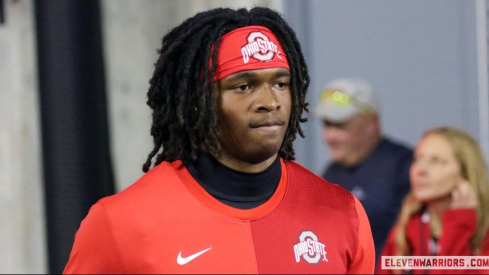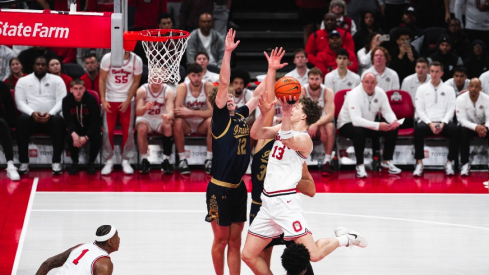
Today I pick up my examination of Urban Meyer's base offense, specifically his passing game concepts. I shift from the base pass plays that comprised Meyer's offense since he became a head coach at Bowling Green to those that have become prominent since his move to Ohio State and collaboration with Tom Herman.
Snag
Of those more recent concepts, snag is perhaps first and foremost.
Snag is an example of a triangle stretch that I described last week. In brief, an offense can never be sure what coverage a defense will run. A triangle stretch seeks to combat that by providing both a vertical and horizontal read that gives an quarterback options no matter what coverage is presented. The goal, in effect, is use three wide receivers to incorporate two route combinations into one play.
Snag is generally run into trips (i.e. three receivers to one side). The middle receiver runs a corner route, the inside receiver a flat route, and the outside receiver runs a mini-curl, looking to sit down in available space.

Chris Brown writes that this combination provides a quarterback the following options
As a general matter, against a Cover Two defense the quarterback will have a high/low read of the cornerback; if he sinks back he can throw it to the inside receiver in the flat; if the cornerback drops he will throw it to the corner route behind the cornerback [Editor's Note--This hi/lo is similar to the 'Smash' concept]. Against a Cover Three defense, the cornerback should take away the corner route by dropping into the deep third, but the snag/mini-curl and the flat should put a horizontal stretch on the flat defender and one of the two should be open. [Editor's Note--This is similar to a curl/flat combination].
In other words, snag is effectively a combination of smash and curl/flat. Against man coverage, the corner route could beat his man deep, or the mini-curl can work to get open in space, similar to the H-option play.
One can see why this play would be appealing to Meyer. It is another opportunity for a receiver to find space inside to get open against underneath coverage. The snag route also initially looks like a shallow cross, making the plays look alike and preventing a defense from pattern reading.
OSU particularly likes this play off sprint out action. Last year the coaching staff moved Corey Brown around to feature on snag, depending on the objective. When they were seeking third down conversions they put him outside and let him work to get open on the curl.
When OSU was in the red-zone they liked to place Brown in the slot, and use the mini-curl as a natural pick for the flat route.
Levels
Levels was another OSU staple last fall, particularly against cover-1 or cover-2. The concept is essentially a mirror of the shallow cross play drive. The outside receiver runs a 5 yard in route, with the inside receiver running a 10-12 yard square in.
The goal is to create a hi-lo vertical stretch on an underneath linebacker. The read is from the underneath route to the square-in. If the defense provides the underneath route the offense takes it. For instance, in the clip below, the inside linebacker deepens to the square-in, allowing the underneath route to come open.
Like snag, levels also mirrors another play, namely smash, another base concept against cover-2. With smash the outside receiver runs a 5 yard hitch, while the inside receiver runs a corner route.
The vertical releases look identical to defenders, again preventing a defense from jumping routes based upon the receivers' initial movement.
By now, a pattern should become clear regarding why Meyer likes certain plays, levels included. If it a) allows his receivers to exploit the middle of the field versus underneath defenders and b) looks similar to other pass patterns to prevent a defense from knowing what is coming, chances are good that it will be a Meyer staple.
Combining Concepts
An additional 'evolution' for Meyer's offensive scheme is not a play but an idea – combining two passing game concepts. The genesis of the idea comes from the same purpose as triangle routes. An offense cannot know what the defense will do, so a play caller puts different concepts on either side that are good against different coverages. As I wrote last summer.
As with combining a run and pass, the basic premise is to provide an offense options against today's more versatile defenses. Though a bit simplified, defenses used to hang their hat on a particular coverage, whether it be cover 3 or the 'Tampa 2.' Passing concepts, in turn, are designed to attack one, perhaps two, coverages. For example smash is a route designed to attack cover 2, with a 2 on 1 vertical stretch of the cornerback (see below).
But if the defense is not in cover 2 or otherwise adjusts, the offense is not left with an ideal play call. With defenses increasingly mixing coverages, an offense is increasingly faced with this dilemma.
Enter the idea of combining concepts. The idea is to put a separate coverage beater to each side. For example, an offense can put a route combination that works against cover 2 to one side and cover 3 to the opposite side. Or the offense can place a route that works for zone to one side and man coverage opposite.
The quarterback reads his usual keys pre and post snap. Is the middle of the field open (cover 2, 4) or closed (cover 1, 3)? Once his keys confirm the coverage, he simply works the progression to the appropriate coverage beater to that side.
Meyer and Herman like combining a concept that works the middle of the field with one that attacks outside the hash marks. For instance, one favorite is combining a shallow crossing route such as drive or follow with smash. Another is combining double slants with snag. This combination has the added benefit of different timing for the disparate concepts. Double slants is a quick game play good against man coverage or cover 2 (again providing a hi-lo on a linebacker). The quarterback takes one step (from the shotgun) and reads the play side linebacker. If neither slant is open, the quarterback can then take re-set himself and read the snag progression to the opposite side.
Meyer and Herman's collaboration thus has a common theme. Implementing passing game plays that deal with increasingly complex defensive looks, while remaining true to the passing game principles that Meyer prizes.
Next week I will complete my review of Meyer's offense by examining his emphasis on the play action and movement passing game.

